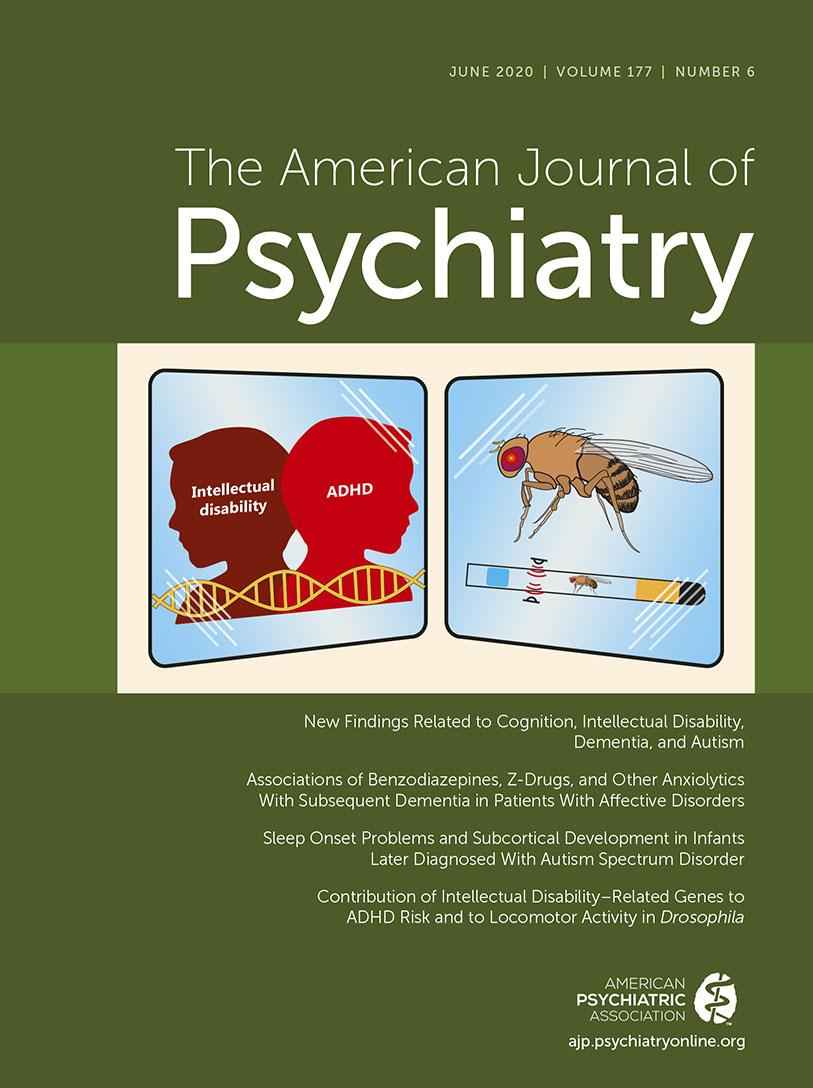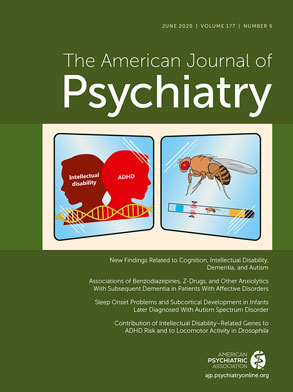Neurodevelopmental disorders include diverse and complex conditions characterized by impairments in cognitive function, adaptive behavior, and/or psychomotor skills. Attention deficit hyperactivity disorder (ADHD), the most common of these disorders in childhood, is highly heritable (∼70%) (
1). However, despite recent advances in next-generation sequencing facilitating gene discovery efforts, the search for ADHD risk alleles has been challenging, mainly because of the polygenic nature of the disorder (
1). Indeed, most associations have been attributed to common gene variants with small effect size, with the first genome-wide significant findings reported only recently (
2). Furthermore, genome-wide association studies (GWASs) typically implicate large regions containing many genes, rather than individual genes or a causal variant, and the significance of those genes and their mechanistic roles often remain unclear. In response to these challenges, animal models have emerged as powerful complementary tools to study the genetic determinants of ADHD and other neurodevelopmental disorders (
3).
Recent changes in the diagnostic criteria for neurodevelopmental disorders have revealed a considerable degree of clinical overlap and comorbidity across different conditions, which include ADHD, intellectual disability, and autism spectrum disorder, among others (
1). Consistent with this, emerging evidence increasingly points to a significant overlap in the genetic etiology of these disorders. This has presented new and exciting opportunities for gene discovery, as is elegantly showcased by Klein et al. in this issue of the
Journal (
4). Their study utilizes a robust discovery-replication design to examine the extent of association of intellectual disability susceptibility genes with ADHD risk. Historically diagnosed by presentation of an IQ <70, intellectual disability has more recently been diagnosed on the basis of the severity of the disruption of adaptive skills necessary for daily life, such as problem solving, abstract thinking, and learning from experience (
1). Unlike ADHD, intellectual disability is often monogenic, with genetic causes accounting for 5% of cases, and attributed to several rare mutations in distinct genes (
1). To examine the overlap between the genetic etiologies of the two disorders, Klein et al. queried whether genes carrying rare mutations linked to intellectual disability are associated with ADHD through common variants. The authors tested a curated set of intellectual disability genes for association with ADHD using the Psychiatric Genomics Consortium ADHD GWAS meta-analysis data for the discovery phase and an independent cohort from the Lundbeck Foundation Initiative for Integrative Psychiatric Research for replication. Remarkably, they found significant overall association of the intellectual disability gene set with ADHD risk. They identified three genes that were significantly associated with ADHD risk across multiple publicly available ADHD data sets and went on to validate and functionally characterize the role of these genes in locomotor activity, taking advantage of readily available resources for targeted gene study in
Drosophila.
Since the advent of the field of neurogenetics, attributed in large part to pioneering work from Seymour Benzer’s group in the 1960s,
Drosophila has enabled groundbreaking research in neuroscience, including the discovery of circadian clock genes and the identification of genes critical for learning and memory (
5)—behaviors that are critically disrupted in ADHD and other neurodevelopmental disorders. Recent innovations in genetic and behavioral technologies have accelerated gene discovery efforts and facilitated the study of increasingly complex behaviors. Fly strains with disruptions in gene function for a majority of
Drosophila genes are readily available. Binary transcription systems such as UAS/GAL4 enable tight spatial and temporal control of gene expression and are widely used for tissue-specific RNA interference–mediated knockdown (
6). Taking advantage of these tools, Klein et al. tested whether knockdown of the candidate genes they identified would lead to dysregulation of activity and/or sleep in flies. They and others had previously established
Drosophila as a robust model for the study of ADHD-associated phenotypes, including hyperactivity and sleep deficits (
7–
9). Basal fly activity and sleep are modulated in large part by dopamine neurotransmission, which is believed to be disrupted in ADHD. Mutation of the dopamine transporter, the main target of psychostimulants used to treat ADHD, leads to hyperactivity in flies, as does mutation or knockdown of the fly homologs of several genes linked to ADHD (
7–
9). Remarkably, treatment of flies with psychostimulants produces the same paradoxical effects observed in humans and in rodent models, reducing the hyperactivity observed by disruption of dopamine transporter and other ADHD susceptibility genes, while inducing hyperactivity in the isogenic controls (
7). The ease of genetic manipulation in flies has further been instrumental in modeling the distinct mechanisms of action of the psychostimulants amphetamine and methylphenidate at the dopamine transporter in vivo (
10).
Of the three intellectual disability genes identified by Klein et al. to be strongly associated with ADHD, they validated two that are conserved in Drosophila: Myocyte Enhancer Factor 2C (MEF2C) and Trafficking Protein Particle Complex 9 (TRAPPC9). The authors used targeted RNA interference to knock down gene expression pan-neuronally and in specific neurons, with the aim of identifying the neuronal pathway(s) in which each gene mediates its function. They measured activity and sleep of flies reared either in a 12-hour light-dark cycle or in constant darkness, when dopaminergic phenotypes are most apparent.
MEF2C is a transcription factor that functions during early development; knockout mice die in utero as a result of irregular development of cardiac muscle (
11). In the nervous system,
MEF2C has been implicated in the regulation of synaptic development, as well as neuronal proliferation, differentiation, and survival. Therefore, targeted knockdown of
MEF2C is critical to bypass early lethality and determine its specific role in the nervous system. Klein et al. found that pan-neuronal knockdown, as well as knockdown only in dopamine neurons, decreased sleep and increased activity over time, suggesting that
MEF2C acts in dopamine neurons to mediate its behavioral effects. Notably, the flies were less active while they were awake but were awake for longer periods, suggesting a more prominent role for
MEF2C in regulating sleep than in regulating activity per se. Knockdown in circadian neurons was lethal, prohibiting the study of
MEF2C function in these neurons, but alluding to a potential critical role for the protein in circadian function (
4).
In addition to aiding intracellular protein trafficking,
TRAPPC9 activates NF-kappa B signaling, which regulates an array of cellular functions, ranging from immune response to neuronal development and synaptic plasticity (
12). Patients with severe forms of intellectual disability caused by loss of function of
TRAPPC9 exhibit defects in axonal connectivity (
13). Klein et al. found that dopamine-specific and circadian-specific knockdown in flies produced significant and divergent changes in activity. Knockdown in dopamine neurons decreased daytime activity with no change in nighttime activity, whereas knockdown in circadian neurons produced an increase in nighttime activity with no change in daytime activity. Notably, knockdown of expression of either
TRAPP9C or
MEF2C increased hyperactivity in constant darkness. These results are consistent with
TRAPPC9 contributing to locomotor activity by modulating distinct, and possibly opposing, pathways, and they highlight the need for an efficient system, such as
Drosophila, that allows for high-throughput mechanistic studies in selected neuronal populations.
With the relevant neuronal populations identified, it will be of great interest to explore the mechanisms underlying the roles of both
MEF2C and
TRAPPC9 in regulating activity and sleep-like phenotypes. Recent innovations in genetically encoded sensors and imaging techniques in
Drosophila provide researchers with unique capabilities to visualize the dynamic processes regulating neuronal function in vivo (
14). Furthermore, brain activity in the form of local field potentials can be reliably recorded from the brains of awake, moving flies, and these measures have been shown to correlate with the activity state of the animals (
15). To investigate the functional contribution of these genes to early neurodevelopment, which is of critical importance in the study of neurodevelopmental disorders, the Gal4 system can be fine-tuned temporally by coexpression of the temperature-sensitive
GAL4 repressor Gal80
ts, so that
GAL4-induced expression of RNA interference is active only during periods when the experimental animals are shifted to a higher temperature (
6). Further behavioral exploration could take advantage of various learning and attention assays developed in flies. These include classical conditioning paradigms (
16) as well as assays that measure attention directly by testing the ability of the flies to suppress competing stimuli, such as a modified “Buridan’s paradigm” in which flies must attend to naturally salient visual stimuli in spite of distractors, in addition to the more complex optomotor maze assay, in which moving gratings influence the successive turning choices of the fly (
17).
It is quite remarkable that genes picked first on the basis of their association with intellectual disability in humans prove to play distinct roles in locomotor activity and sleep-like behaviors in flies. Together with the finding that the intellectual disability gene set as a whole was significantly associated with ADHD risk, these results support the need for more research exploring comorbidity within neurodevelopmental disorders, to reduce the degree of diagnostic overshadowing when treating patients with intellectual disability. As the authors suggest, genetic overlap may indicate biological pleiotropy, whereby distinct variations in the same gene cause different disorders to develop, depending on the severity of the variation. To test this hypothesis, functional studies can be conducted in the context of replacing the
Drosophila gene with its human homolog to model the pathophysiology of gene variants linked to the disorders (
18).
There obviously remain limitations to the use of
Drosophila for this type of investigation. Of the three intellectual disability genes highlighted in the study, the authors identified ST3 Beta-Galactoside Alpha-2,3-Sialyltransferase 3 (
ST3GAL3) as the gene most strongly associated with ADHD, but it has no clear homolog in
Drosophila. Furthermore, studies of disorders of higher cognition like ADHD and intellectual disability require follow-up studies in rodents, which are better suited to model cognitive dysfunction and the relevant circuit abnormalities driving it. Nevertheless, this study highlights the potential of
Drosophila as a powerful tool for prioritizing and validating candidate genes identified by gene association studies. Although
MEF2C and
TRAPPC9 are located in loci previously found to be associated with ADHD, neither was highlighted in the GWAS study, passed over for different genes in the loci with more compelling published research results (
2). Thus, the study conducted by Klein et al. succeeded in prioritizing two previously associated, but overlooked, ADHD susceptibility genes. This demonstrates the value of innovative, multidisciplinary approaches to gene discovery to fill the gap in our understanding of the etiology of ADHD and other neurodevelopmental disorders and guide the development of novel therapeutics to help those for whom current treatments remain ineffective.

